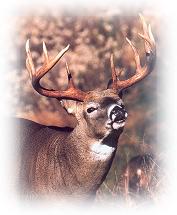Years ago, hunters often organized drives that consisted of 200 or more hunters, joining forces to cover a mile wide section of forest, sometimes killing more than 100 deer. Drives today are smaller, but are no less effective. The usual drive consists of a group of walking hunters who push deer downwind or crosswind past waiting hunters orposters. In some states, the hunters use dogs in these drives. Drives are most effective in isolated patches of cover where deer must funnel through narrow passages or run into the open. Some of the best sites for driving include cornfields, sloughs, and woodlots. Posters will often sit in elevated stands so they can easily spot the fleeing deer and the most likely escape routes. Another advantage to using elevated stands is they're safer than ground-level stands because the posters are above the line of fire.
Every drive should be organized by a safety conscious leader who is familiar with drive hunting proceedures and the land the drive is taking place on. This leader is responsible for making sure the area that is driven is clear of hunters, and he is also responsible for making sure that drivers and posters are acquainted with the drive area. A map or aerial photograph of this land is especially helpful.
Typically, the leader assigns more drivers than posters. How far the drivers should spread out is dependant on the density of the land cover. Too much space causes drivers to lose track of each other and allows deer to hide easily. Some drive leaders assign "flankers" to catch deer attempting to sneak off. Although some drivers believe in making a lot of noise, you'll move just as many deer and get much better shots with a quieter drive.
Make sure you walk slowly because your scent will drift ahead of you causing deer to move along possible escape routes. Posters should be ready to shoot the deer as they slowly move past the stand or stop at the edge of the cover. If the deer escape into the open, they will usually be running, making it much more difficult to shoot them. Always keep the drive moving as originally planned, even if a deer is killed or wounded. Carefully mark the locations of downed deer.
After the conclusion of the drive (as signalled by the leader with a whistle), return to field-dress the deer or follow any bloody trails they may have left. In many states, you may need to tag a deer immediately upon shooting him. Drive-hunters should familiarize themselves with all local party hunting regulations before embarking on a drive. |

